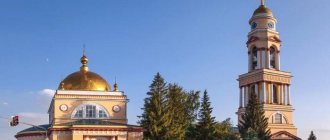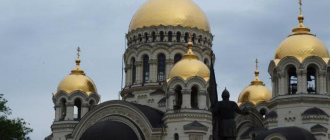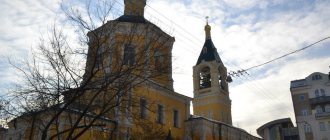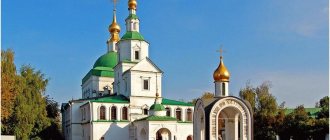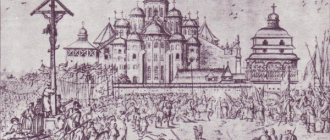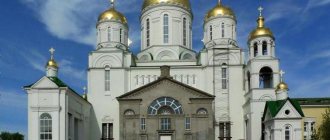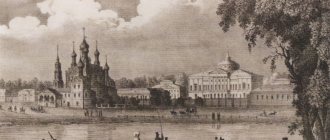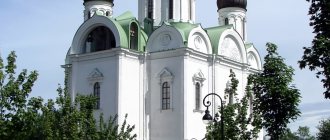"Save me, God!".
Thank you for visiting our website, before you start studying the information, please subscribe to our Orthodox community on Instagram, Lord, Save and Preserve † - https://www.instagram.com/spasi.gospodi/. The community has more than 60,000 subscribers. There are many of us like-minded people and we are growing quickly, we post prayers, sayings of saints, prayer requests, and timely post useful information about holidays and Orthodox events... Subscribe. Guardian Angel to you!
Novocherkassk Ascension Military Cathedral is a great shrine of the entire Orthodox world. It is known not only for its historical influence, but for its enormous spiritual significance, which righteous believers listen to in order to gain an even deeper knowledge of the Word of God and its eternal grace. Read more about the history of the temple, the conduct of services and address information later in the article.
History of the foundation of the Ascension Cathedral
Don Ataman Matvey Platov initiated the construction of a Christian cathedral in Novocherkassk. He wanted to build a temple that would be the largest and most beautiful in Russia.
In 1805, on the Orthodox day of the Ascension of the Lord, the site was consecrated for the construction of a temple. This date is considered the founding day of the cathedral, hence its name - Ascension. In addition, 1805 is also considered the year of the founding of Novocherkassk, so the fate of the temple and the city are inextricably linked.
In fact, construction of the temple began only 6 years later, in 1811. The design of the cathedral was developed by the Swiss architect Luigi Rusca, who supervised the construction until 1818. It is noteworthy that the wide road to the temple was also laid in advance, for which a vast area near the construction site was leveled.
The scale of construction was impressive for that time. For example, to provide workers with building materials, a brick factory was built in Novocherkassk, producing 2 million bricks per year. For construction needs, they used their own power plant, water supply and even a laboratory where materials were tested for strength.
Video: history of the Novocherkassk Ascension Military Cathedral
Destruction of the cathedral
In 1818, the construction of the Ascension Cathedral was headed by the architect M. I. Amvrosimov. On his initiative, in subsequent years, work was carried out to strengthen the structure of the temple: wooden window bars were replaced with iron ones, and the seaside building stone was replaced with the more durable “Grushevsky”.
Despite these efforts, in 1828 a crack was discovered in the building's masonry. Investigations were conducted for several years, but the building was not considered dangerous. Construction continued until in 1846 the cathedral building suddenly collapsed during the construction of the main dome. The commission to investigate the causes of the destruction of the cathedral named two possible reasons: soil shrinkage and incorrect calculation of the weight of the structure.
The construction work was continued by the architect Ivan Osipovich Valpreda, who proposed his project for the restoration of the cathedral. The construction of the temple began almost anew. The task before the craftsmen was not easy: they had to build the cathedral in a relatively short time. In addition, limited funds were allocated for the re-construction. As a result, several years later it turned out that the brick used was of poor quality. But it had already been laid at the foundation of the cathedral, so work continued at a slow pace. In 1863, the main dome of the Ascension Cathedral collapsed, along with the side vaults and part of the small domes.
What time and when will the water in the temple be blessed?
At Epiphany, the water is blessed twice: the first time on Christmas Eve, and the second, in fact, on the feast of Epiphany.
On January 18, on Christmas Eve, after the liturgy, the great consecration of water takes place in churches. The blessing of water is called great because of the special solemnity of the rite, imbued with the memory of the gospel event, which became not only the prototype of the mysterious washing of sins, but also the actual sanctification of the very nature of water through the immersion of God in the flesh. This water is called Agiasma, or simply Epiphany water. Under the influence of the Jerusalem Charter, from the 11th-12th centuries, the blessing of water occurs twice - on January 18th on Epiphany Eve, and directly on the feast of Epiphany on January 19th. Consecration on both days takes place in the same manner, so the water blessed on these days is no different.
On January 18, Epiphany water will be distributed to everyone after the Great Consecration (at approximately 10:30) until 16:00
Epiphany water is consumed on an empty stomach in small quantities all year round, usually together with a piece of prosphora “so that we can receive strength from God that supports health, heals illnesses, drives away demons and turns away all the slander of the enemy.”
At the same time, the prayer is read: “Lord my God, may Your holy gift and Your holy water be for the remission of my sins, for the enlightenment of my mind, for the strengthening of my mental and physical strength, for the health of my soul and body, for the subjugation of my passions and infirmities according to Your boundless mercy through the prayers of Your Most Pure Mother and all Your saints. Amen". In case of illness or attacks by evil forces, you can and should drink water without hesitation at any time.
A special property of holy water is that, added even in small quantities to ordinary water, it imparts beneficial properties to it, therefore, in case of a shortage of holy water, it can be diluted with plain water.
Construction of a new temple
Only in 1893 did the construction of the new Ascension Cathedral begin. The third project was headed by academician Alexander Aleksandrovich Yashchenko. This time the construction was completed successfully, the temple was consecrated in 1905 and opened to parishioners.
The new six-domed cathedral was built in the New Byzantine architectural style. It is mainly built of brick, but the vaults of the new temple are made of reinforced concrete. Thanks to this, the construction of the cathedral became significantly lighter.
Construction costs exceeded 2 million rubles. The total period of construction of the temple from the date of its foundation was 100 years. Despite the fact that the cathedral collapsed twice, the skill of the architects and builders is admirable. For example, 9 cast gilded bells with a total weight of 33 tons were lifted to the bell tower by ropes.
Video: three-dimensional overview of the Novocherkassk Patriarchal Ascension Military Cathedral
Epiphany Eve service
Traditionally, the Royal Hours (beginning at 07:00) and Vespers with the reading of paremias (excerpts from the books of Holy Scripture) and the Liturgy of Basil the Great are celebrated in the church on this day, that is, this is a very large service, similar to those performed on Christmas Eve and on Holy Saturday.
All liturgical texts of this day are dedicated to the Baptism of the Lord and the Epiphany. The Liturgy on this day begins with Vespers, that is, this is an unusual type of Liturgy, which is performed only a few times a year - Christmas Eve, Epiphany Eve, Maundy Thursday and Great Saturday.
Architectural features of the Ascension Cathedral
Novocherkassk Ascension Cathedral is the greatest architectural monument of Russia, along with the Cathedral of Christ the Savior and St. Isaac's Cathedral.
The ideal of Byzantine architecture is considered to be the St. Sophia Cathedral in Turkey, on the model of which religious buildings were erected in the 19th century, including the Ascension Cathedral.
The neo-Byzantine style is characterized by domes of a special squat shape, half protruding from the roof, and a main dome larger than the rest. The large dome is supported by four powerful pillars. Window arcades frame the domes below.
The building consists of three rooms: the upper and lower basements and the temple itself. The lower basement is used to store cultural treasures and icons. In the upper basement there is a tomb where the heroes of the Don Cossack army are buried. Inside the cathedral, a large undivided space creates a feeling of majesty and freedom.
Temple in post-revolutionary times
Soon the time of unrest and revolution came, and the temple was closed. In the turbulent 1930s, the gilded copper sheets were removed from the domes, turning the cathedral into a storage facility for fuel and lubricants. During the German occupation (in August 1942), the temple was opened for worship. And after the end of World War II, grain, flour, beer malt, sugar and other food were stored in the spacious basements of the temple. But services were occasionally held in the upper church.
The year 1953 became a saving year for the gradually collapsing building of the Holy Ascension Cathedral. After Stalin's death, the temple came to the attention of historians. Renovation work began here, both internal and façade. In 1974, the building was awarded the title of an architectural monument of local significance, and in 1995 - federal. Large-scale restoration has continued from 2001 to the present day.
But one way or another, after almost a century, the cathedral is again open for worship, services and visits. Everyone can come here, feel the beauty and scale of this unique temple, whose fate was as difficult as the fate of our country at the turn of the era.
Interior decoration
The interior of the Ascension Church is distinguished by its majesty and solemnity: high arches and vaults, marble iconostases and icon cases flooded with light, walls painted with Christian themes. The floor is covered with 5,600 slabs of marble in pink, grey, green and white.
View from the main entrance
The central dome of the Ascension Cathedral: view from the inside
Altar of the Ascension Cathedral
The ancient unique frescoes are of particular value; there are about 200 of them in the cathedral and they have been perfectly preserved to this day. None of the visitors to the temple, parishioners and tourists, are left indifferent by the beauty and richness of the interior decoration of the cathedral.
Video: worship in the cathedral, an overview of the entire temple from the inside
Worship in the temple
The Ascension Cathedral houses famous Christian shrines, such as the Icon of the Dormition of the Mother of God. Parishioners of the temple can attend services that take place daily.
Morning services will take place at 7 a.m. and evening services at 6 p.m. Prayers are also held at 12 o'clock every weekday for various everyday needs: family and material well-being, for the sick, and others.
Occasionally, changes may be made to the regular schedule of services. Festive services dedicated to significant Christian dates are especially solemnly held in the cathedral.
Festive services in the Cathedral of Christ the Savior in Moscow on January 18 and 19 for the Epiphany of the Lord
The Eve of Epiphany - Epiphany Christmas Eve
January 18, Tuesday
8.30 Great hours, pictorial, confession.
10.00 Great Vespers, Liturgy of St. Basil the Great. Church of the Transfiguration. Great consecration of water.
17.00 All-night vigil.
Holy Epiphany - Baptism of the Lord
January 19, Wednesday
8.00 Confession.
9.00 Liturgy.
17.00 Vespers, matins.
How to get to the Ascension Cathedral in Novocherkassk?
The Ascension Cathedral is located at the address: Russia, Rostov region, Novocherkassk, st. Alexandrovskaya, 78A
Novocherkassk is located near Rostov the Great, from where you can get here by bus, train or car along the M4 highway.
You can see the Ascension Cathedral from almost anywhere in the city, as it is located on a hill.

